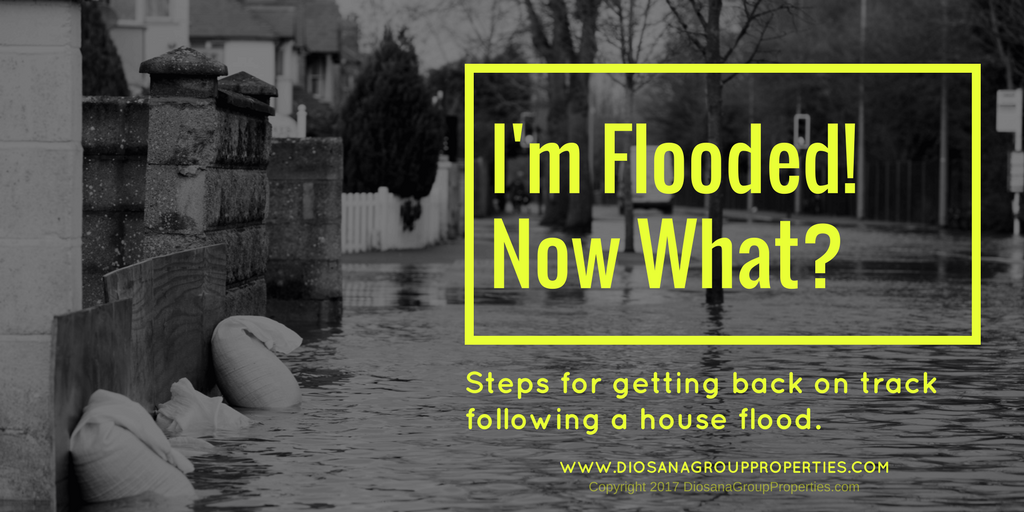I’ve Flooded, Now What

Houston overcame an unquestionably challenging hurricane season this year. The effects of Harvey reverberate today and will continue to for some time. Homeowners in the floodplain and out all felt the devastating effects of massive natural and deliberate flooding. The population of Houston has grown considerably over the last several years. For many people, this was the first hurricane to strike Houston with this level severity. If your house has been flooded by a storm or something else, these 5 steps can help you get back on track:
1: Stopping the Water Flow
Only if possible, and only if safe to do so. Sometimes, flooding may be caused by plumbing or exterior leak. Turning off water sources can stop plumbing leaks while awaiting repairs. Water leaks through window frames, cracks in the foundation, or other structural cause can be stopped using caulk and other materials available at a local hardware store. For severe floods, such as those caused by and related to Harvey, simple measures will have little effect. In cases of natural disaster always prioritize safety. In cases of major flooding, proceed to step number two.
2: Minimizing Flood Damage
Rising water levels are a good sign it is time to start moving valuables to higher positions. When possible to do so, safely move rugs, furniture, electronics and any other valuables above rising waters, or away from the water flow. While damage to the home may be unavoidable, saving as many items as possible can help limit stressors following the flood. Always place a higher value on safety than on possessions.
If possible disconnect appliances, shut off the gas and turn off water supplies before evacuating. This can help reduce flood-related damage to other appliances and the home.
3: Responding to Flood Damage
In simple flooding cases, response begins once the water ceases to flow. For major disasters like Hurricane Harvey, the response may take longer. Evacuees in a hurricane may return only when cleared to do so. This means alongside flooding, homeowners may deal with extra damage from criminals, wildlife, chemicals and/or sewage. Approach flooded homes with caution. Document all damage from the flood and related causes thoroughly. Once the damages are logged, it’s time to file an insurance claim or, in cases of federal emergency, homeowners without flood insurance may apply for federal aid.
Filing flood insurance claims. Homeowner’s insurance policies do not automatically cover damages caused by flooding. Flood insurance policies are separate. Comprehensive flood insurance is available through a local broker, and general packages are available through FEMA. Contact the insurance agency as soon as possible to file a flood insurance claim. Photos and detailed logs of flood damages can be helpful when filing, and when working with a claims adjuster.
Applying for Federal Aid. After severe natural disasters, the government may declare a federal emergency. When a federal emergency is declared, FEMA disburses federal aid to affected areas. FEMA disaster aid covers a number of needs homeowner’s have following a flood such as uninsured home repairs, temporary housing aid, childcare assistance and more. For more on the federal aid programs available through FEMA visit DisasterAssistance.gov.
4: Cleanup Following a Flood
Much more than a simple tidying, home cleanup following a flood can be very involved. Homes may have standing water, live animals, and any number of contaminants inside. Safety is always most important. Throw away spoiled, rotten, and other inedible food. Err on the side of caution. Handle hazardous materials carefully, and wear all appropriate safety clothing and equipment. Mold risks following a major flood are high. In extreme cases, professional mold remediation crews may be necessary for full removal of spores.
Sort personal possessions into those to keep, and those to discard. Discard any items having absorbed excess flood waters, have become damaged by mold, or otherwise present a safety hazard. Any kept items should be disinfected and cleaned before returning to regular use. Throughout the cleanup process maintain awareness of personal safety and health, cleaning and disinfecting often.
5: Move Forward
Floods are inconvenient and unwelcome no matter the size or season. For small floods, cleanup may be minimal. For large floods, entire communities may be affected. After a flood, it can seem like the world has been turned upside down. The most important thing to do following a flood is to pick up your feet and move forward. Prepare for construction, bureaucracy, and a lot of takeout food.
Flood insurance policies generally have 30 days after implementation to take effect. This means that by the time you know a flood is coming, it’s too late to purchase flood insurance coverage. Houston is a rainy and wet place. Hurricane Harvey taught Houstonians nowhere is safe from the effects of flooding. Explore flood insurance options through a local insurance broker or through the government.
Hurricane season returns to Houston and the Gulf Coast every year. Major storms really are a matter of “when” they’ll hit. Prepare with a flood plan.

